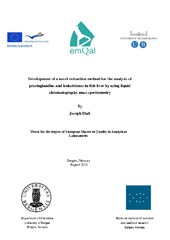Development of a novel extraction method for the analysis of prostaglandins and leukotrienes in fish liver by using liquid chromatography mass spectrometry
Master thesis
Permanent lenke
https://hdl.handle.net/1956/10656Utgivelsesdato
2015-09-06Metadata
Vis full innførselSamlinger
- Department of Chemistry [432]
Sammendrag
Eicosanoids are the major metabolites of fatty acids and they have pro-inflammatory anti-inflammatory proprieties, their role and production in solid biological tissue is important due to correlation with many kinds of diseases. A simple and rapid liquid extraction method for extracting prostaglandin E2 (PGE2) and leukotriene B4 (LTB4) from salmon liver and further determination by LC-MS/MS was developed and validated. The optimal combination of chloroform, acetonitrile and formic acid was investigated by simplex extraction design. The applied criteria for selecting the optimal mixture composition were the visual observation of clearness of supernatant after centrifugation, and the strength of signals represented by peak areas of extracted ion chromatogram (EIC). Adding 500 µL of acetonitrile and 500 µL of chloroform subsequently to 0.3 g of pulverized liver sample was found the optimum extraction system. Formic acid dissolved the liver tissue and was ruled out. The quantitative analysis was carried out using internal standards and the concentrations of internal standards are determined by a Doehlert design to keep the response factors constant in the analytical range. After the determination of the endogenous level of PGE2 and LTB4 in the working sample the method was submitted to validation. The proposed method exhibited good selectivity and linearity over the range (1-50) ng/g for both LTB4 and PGE2 respectively. In addition, the endogenous levels for PGE2 (87 ng/g) and LTB4 (101 ng/g) indicate that the system linearity could be extended until 137 ng/g and 151 ng/g respectively. A full method validation has been performed, the considered validation parameters were: selectivity, limit of detection, limit of quantification, linearity, analytical range, precision recovery and stability. Also, since a blank sample was not available, the relative limit of quantification taking the endogenous level was considered. The method precision for LTB4 quantification was found 19-20.6% and the recovery ranged between 98.4-104%, the relative limit of quantification was found 15.5%. Both PGE2 and LTB4 were found stable at -80C° in a solution of acetonitrile:chloroform (1:1) after 24 hours.
